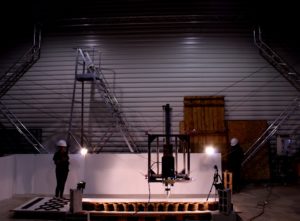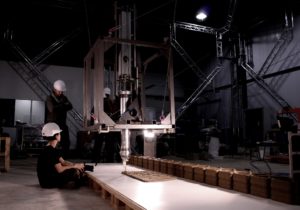 Out of all the industries that have adopted 3D printing, construction was one of the slower ones to begin integrating the technology. As an old, long-established industry, the field of construction was somewhat resistant to change – but when it did begin opening up to new ideas and technology such as 3D printing, it seemed to happen all at once. Now a wealth of companies have emerged with their own methods of 3D printing buildings, each one striving to outdo all others in creating better, stronger, more innovative buildings at a faster speed.
Out of all the industries that have adopted 3D printing, construction was one of the slower ones to begin integrating the technology. As an old, long-established industry, the field of construction was somewhat resistant to change – but when it did begin opening up to new ideas and technology such as 3D printing, it seemed to happen all at once. Now a wealth of companies have emerged with their own methods of 3D printing buildings, each one striving to outdo all others in creating better, stronger, more innovative buildings at a faster speed.
The Institute for Advanced Architecture of Catalonia (IAAC) has been researching 3D printing in construction for a while, and has developed a technology called Pylos. The methodology grew out of a research project aimed at creating a new architectural 3D printing technique that relied strictly on natural, biodegradable, local materials that could be recycled after they had served their purpose. While not the first organization to explore this type of 3D printed construction, IAAC’s method is a bit different in that rather than altering the natural material to fit its needs, Pylos lets the material shape the technology.
“The objective was to develop a technique that went beyond the robot – relying only on its mechanical properties – and allowing a design research based exclusively on the material properties and behaviour,” IAAC states. “This research process included the optimisation of material mix, using only natural additives, as well as optimizing fabrication times…The material cannot be other than soil.”
 The first phase of the project has resulted in a material that is 96% soil-based and, according to IAAC, has three times the tensile strength of industrial clay. It’s also unbaked, meaning that it can be reused again and again or simply return to the soil, unlike fired clay.
The first phase of the project has resulted in a material that is 96% soil-based and, according to IAAC, has three times the tensile strength of industrial clay. It’s also unbaked, meaning that it can be reused again and again or simply return to the soil, unlike fired clay.
The Pylos project led into the TerraPerforma project, which was undertaken as part of IAAC’s Open Thesis Fabrication Program. The objective was to create a prototype structure that would demonstrate the ability of clay to serve as an effective construction material for any type of architecture, despite the fact that it’s generally associated, according to IAAC, with construction in underdeveloped, poor areas.
While clay may be one of the oldest building materials in existence, there was nothing antiquated or low-tech about the TerraPerforma project. The team used software including Rhino CFD, Ladybug and Karamba to simulate wind, sun and the resulting behavior of clay structures, and tested both digital simulations and physical 3D printed structures to evaluate the material’s performance when exposed to natural climactic features. Factors tested included:
- Solar radiation
- Daylight
- Thermal conductivity
- Thermal convection
- Thermal mass
- Structural behavior
Ultimately, the team decided that a modular building approach would be most effective, due to the difficulty of bringing a robot into the harsh weather conditions that can plague on-site building projects. Each module was parametrically designed for optimum performance depending on solar radiation and wind, and was 3D printed as a gradient both horizontally and vertically in order to optimize sunlight from both the east and west. To further maximize sunlight and channel wind, the modules were designed with several strategically placed openings.
IAAC also worked with Tecnalia, which brought its CoGiro robot to the project. CoGiro is a Cable-Driven Parallel Robot (CDPR), a massive robot designed for construction that allowed the team to create the largest monolithic piece of the project. The two organizations collaborated not only on TerraPerforma but on a project called On Site Robotics, aimed at demonstrating the effectiveness of 3D printing and robotics in automated on-site construction.
The team developed a 3D printing system that combined IAAC’s Pylos method with the CoGiro robot, controlled by integrated CNC technology that allowed for precise, automated manipulation of a 3D printer extruder. We’ve seen plenty of construction techniques that combine robots with large-scale 3D printing equipment, but the On Site Robotics project added an extra touch: drones. Several of them. Drones were programmed to fly autonomously over the construction site and monitor the printing with multispectral cameras that transmit thermal information about how quickly the material is drying, thus preventing new layers from being deposited onto a still-wet, unstable base.
The advantages of the system, according to the team, are many. The cable-driven robot allows for six degrees of freedom and can be easily installed on-site, doesn’t require a lot of maintenance, and can print large structures for minimal cost.
“Additionally, the process of 3D printing in situ requires a continuous monitoring of the state of the deposited material, the three-dimensional structure, as well as the environmental conditions that might influence its behavior,” the team states. “The aerial robots used in the construction site open new possibilities of real time monitoring and direct communication between machines, people and built products.”
So far, the team has developed an extruder for clay material, but an extruder for cement materials will be created shortly as well. Discuss in the IAAC forum at 3DPB.com.
[Images provided to 3DPrint.com by IAAC – Institute for Advanced Architecture of Catalonia]
Subscribe to Our Email Newsletter
Stay up-to-date on all the latest news from the 3D printing industry and receive information and offers from third party vendors.
You May Also Like
Profiling a Construction 3D Printing Pioneer: US Army Corps of Engineers’ Megan Kreiger
The world of construction 3D printing is still so new that the true experts can probably be counted on two hands. Among them is Megan Kreiger, Portfolio Manager of Additive...
US Army Corps of Engineers Taps Lincoln Electric & Eaton for Largest 3D Printed US Civil Works Part
The Soo Locks sit on the US-Canadian border, enabling maritime travel between Lake Superior and Lake Huron, from which ships can reach the rest of the Great Lakes. Crafts carrying...
Construction 3D Printing CEO Reflects on Being Female in Construction
Natalie Wadley, CEO of ChangeMaker3D, could hear the words of her daughter sitting next to her resounding in her head. “Mum, MUM, you’ve won!” Wadley had just won the prestigious...
1Print to Commercialize 3D Printed Coastal Resilience Solutions
1Print, a company that specializes in deploying additive construction (AC) for infrastructure projects, has entered an agreement with the University of Miami (UM) to accelerate commercialization of the SEAHIVE shoreline...


































